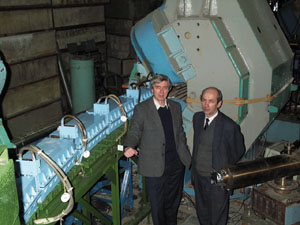
The TeraWatt Accumulator (TWAC) project at Moscow’s Institute for Theoretical and Experimental Physics (ITEP) has successfully passed its proof-of-principle test. A bunch of carbon-4+ ions from near the laser ion source were pre-accelerated in the accelerator/ accumulator facility’s new U-3 pre-injector, injected and accelerated in the UK booster ring to 300 MeV per nucleon, stripped down to 6+ and stacked into the U-10 storage ring.
This marks the completion and commissioning of the new facility’s main systems – ion source, ion pre-injector, radiofrequency and power supply for the booster ring, beam transport lines and pulsed magnetic elements.
The essence of ITEP’s TWAC project is to upgrade and modify the ITEP accelerator complex so that it will have a new unique capability for investigating the following fields:
- extreme states of matter with high density and temperature, and their relation to the physics stellar interiors;
- basic research into the properties of the nuclear matter (relativistic nuclear physics);
- medicine and radiobiology for tumour therapy using carbon ions.
The project takes advantage of a heavy-ion accelerator facility based on two existing synchrotron rings, and it uses a special stripping technique for stacking pulses accelerated in the UK booster into the U-10 storage ring.
For this first phase the ion source, based on a 5J/0.5 Hz TEA CO2 laser, has been operated and installed in the U 3 pre-injector area. The 20 mA/20 µs carbon ion beam was matched to the 2 MV/2.5 MHz pre-injector.
The accelerated 16 MeV carbon-4+ ion beam was guided by the new beam transport line to the UK ring and injected. The intensity measured at the injection point is around 1.5 x 1010/15 µs. The carbon beam is then circulated in the UK ring at constant field.
The power supply of the UK booster ring magnets, of the vacuum system and of the radiofrequency accelerating cavities has been upgraded and the carbon beam accelerated to 300 MeV per nucleon.
Magnetic components of the beam-transfer line connecting the UK and U-10 rings required for the multi-turn injection scheme have been manufactured, installed and adjusted.
For the second phase of the project, the beamline for extraction to the beam-target interaction area will be designed and constructed this year. Focusing elements and the interaction vacuum chamber will be manufactured and installed in the experimental area.
Special attention will be paid to research and development for modern and sophisticated diagnostics for measurements of dense plasma parameters under unique conditions.
Two new beam transport lines and related slow extraction systems will be designed for beam delivery to the medical and nuclear physics experimental areas. The application of electron cooling for increasing the phase space density of accumulated beam will be investigated and the design of the new linac-injector will be completed.
During the third phase (January 2002 – December 2003), experimental facilities for medical physics and for relativistic nuclear physics will be commissioned. A powerful CO2 laser with 100 J/20 ns output at 1 Hz will be set in operation.
Together with the upgrading of the main accelerator-accumulator systems and with implementation of the pulse compression system, the intensity of the heavy-ion beam will then reach the maximal (target) values:
- in ion acceleration mode, supplying up to 4.3 GeV/nucleon and up to 1011 particles/s;
- in ion accumulation mode, 300-700 MeV/nucleon and10121013 particles per 100 ns (approximately) pulse;
- in medical application mode, some 250 MeV/nucleon, 109-1010 particles/s.





